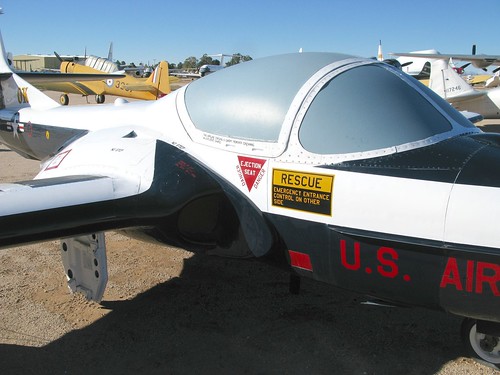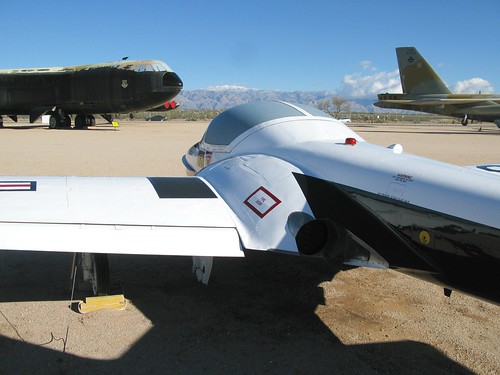- THROTTLES—IDLE
- RUDDER AND AILERONS—NEUTRAL
- STICK—ABRUPTLY FULL AFT AND HOLD
- RUDDER—ABRUPTLY APPLY FULL RUDDER OPPOSITE SPIN DIRECTION (OPPOSITE TURN NEEDLE) AND HOLD
- STICK—ABRUPTLY FULL FORWARD ONE TURN AFTER APPLYING RUDDER
- CONTROLS—NEUTRAL AFTER SPINNING STOPS AND RECOVER FROM DIVE
That, if you don’t recognize it, is the boldface spin recovery procedure for the T-37. Student pilots could recite it in their sleep. Instructors had it embedded in their DNA. I have over 1,000 hours in the Tweet and am seriously considering having it engraved on my headstone.

The Cessna T-37 Tweet was the USAF’s primary jet trainer from 1957 to 2001, when its successor, the Beechcraft T-6A, began to replace it. The last USAF T-37 training flight occurred in June 2009 at Sheppard AFB in Texas. Generations of American pilots learned how to fly in the T-37. Some allied nations are still training pilots in it. Not a bad record.
The T-37 was designed to be an economical, all-around primary jet trainer with full aerobatic and instrument flight capabilities. It’s a tiny thing. Sitting side-by-side, the two crewmembers practically rub shoulders. It sits so low to the ground a tall person can hike a leg over the side and step into it as easily as getting into a bathtub. Shorter pilots stick a foot into the little recess with the red cover plate just below the rescue placard, then step over and in; it’s no more difficult than getting into a high-riding pickup truck.

The Tweet isn’t terribly fast. You can get it up to 350 knots, but at that speed the big bubble canopy forces the nose to tuck down and the drag increases to the point where it simply won’t go any faster. It has short legs. I once flew one from Enid, Oklahoma to Tampa, Florida; it took four hops to get that far. There’s a small storage bin in the nose and just room enough to hang a suit bag between the seats. Nevertheless the USAF taught students to plan and fly cross-country trips in the Tweet … learning to pack efficiently is useful training.
The early-style centrifugal flow engines are slow to wind up, requiring you to plan ahead and lead with the throttles. Thrust attenuators stick out into the engine exhaust stream during approach and landing so that you can keep the engines at a fairly high RPM in case you need power quickly for a go-around. The Tweet is unpressurized, limiting it to flight below 25,000 feet. Since you have to constantly clear your ears during climbs and descents, you learn another valuable lesson: never to fly with a cold.
At idle power the T-37’s jet engines generate a piercing whistle; hence the nickname Tweet (and the title of this diary). Flight lines are noisy places: pilots and ground crews wear earplugs when working around aircraft on the ramp. When you fly or work on Tweets, though, you wear big Mickey Mouse ear protectors, and many wear earplugs underneath. I retired from the USAF with a 10% medical disability for hearing loss … all incurred during the first four years of my flying career, first as a student and then as an instructor in T-37s.
The USAF’s pilot training program, at least in the 1970s when I went through, consisted of a short screening program in the T-41 Mescalero (the military version of the Cessna 172), followed by six months in the T-37 and six months in the supersonic T-38 Talon. Beyond soloing in the traffic pattern you didn’t learn anything fancy in the T-41, just the basics of aircraft control. In the T-37, though, you learned it all: contact (VFR) flying, precision maneuvering and aerobatics, flight planning, instrument flight, precision and non-precision approaches, formation flying. The T-38 put a polish on what you’d learned in the T-37, and in addition taught you the flying characteristics of high-performance jets.
When I graduated from pilot training at the end of 1974, the USAF made me a FAIP, a first-assignment instructor pilot. After a three-month pilot instructor training program at Randolph AFB in Texas, I returned to Vance AFB in Enid, Oklahoma, the base where I’d been a student pilot. Now an instructor with students of my own, I flew two to three times a day for the next three years, taking students through the basics, then traffic patterns and touch-and-goes, aerobatics, unusual attitude recoveries, spins, flight planning and cross-countries, IFR flight and instrument approaches, formation work. After two years as a line instructor I became a black-hat check pilot, evaluating the skills student pilots had learned from other instructors. I started my FAIP tour as a butter bar and finished as a new captain. Most of Vance AFB’s Tweets were silver when I started; they’d all been painted white by the time I left (the blue & white paint scheme you see in these photos came along later in the Tweet’s career).

I rode in the right seat, the student to my left. If he screwed up I could tap him on the shoulder, grab his arm, or rap him on the helmet (in my day there were no female students). I saw a fair amount of puke. Some students were naturals; some required more instruction and taught me patience. I quickly learned how important and merciful it could be to wash out a truly inept one.
The T-37’s instrument panel design predates the age of ergonomics. Cross-checking instruments in IFR conditions is hard enough for the student; when the instructor in the right seat flies in the soup he has to read the attitude indicator and performance instruments over on the left side of the instrument panel; all he has on his side is a turn & slip indicator, airspeed indicator, and altimeter … about what a DC-3 pilot in the 1930s would have had. A good T-37 pilot can fly an ILS approach from the right seat while looking at localizer and glidepath needles on a two-inch gauge four feet to the left; I was good enough at it, I guess, because I lived to tell the tale.

I must say the cockpit in that photo is suspiciously pristine. The Tweets I flew were working aircraft, flown several times daily by different instructors and students, not all of whom had cast-iron stomachs. The instruments, as mentioned, date from the age of steam. Tweets of my era were not equipped with TACAN receivers; we used VOR and DME, which was fine since we didn’t fly jet routes anyway (the 25,000 foot limit confined us to the Victor airway structure where the old prop airliners used to fly). When I started flying T-37s most of the fleet still had “black ball” J-8 attitude indicators that you had to re-cage in level flight every 10 or 15 minutes. As you can see, there is no horizontal situation indicator: one navigates with old school heading and radio magnetic indicators. You can’t see it in this photo, but the student had duplicate throttles on the left side console, as well as a gear handle … lack of ergonomics and antiquated instruments aside, the Tweet really is well designed for basic jet training.
Spins? The Tweet was easy to spin and the USAF put a high value on spin recovery training, so spinning was a near daily activity for Tweet instructors and students. The Tweet could be treacherous in a spin, and the recovery procedure outlined above had to be followed exactly and precisely. To enter a spin you climbed to 25,000 feet, pulled the stick back into your lap, and fed in full rudder. At the stall the Tweet snapped into a spin very quickly, with the nose about 45 degrees below the horizon and a very fast rotation rate. You can see what it looked like from the left seat at about the one-minute mark on this video:
Once you executed the boldface the rotation stopped and the nose dropped to about 60 degrees below the horizon, leaving you in a steep dive. You kept the controls neutral and ran the throttles back to full power. As soon as you had airspeed again, you recovered from the dive by pulling to the nearest horizon with your wings level. As I recall you wanted to be out of the spin and back in level flight before you got below 18,000 feet. If you were still in a spin below 14,000 feet it was time to start thinking about ejecting; if you weren’t out by 10,000 feet you pulled the handles, squeezed the triggers, and gave the plane back to the taxpayers. Over the years several instructors and students were killed after botching spin recoveries and staying with the aircraft too long.
Speaking of ejecting, we sat on first-generation ballistic seats: not rocket powered but instead blasted up the rails by a gunpowder charge, basically a land mine under your butt. It was important to pull said butt in and sit up straight during ejection lest the force of the blast break your back. If you were less than 300 feet in the air and slower than 100 knots when you squeezed the triggers you weren’t going to make it. You had to remember to unclip your parachute’s quick-opening lanyard from the D-ring as you climbed above 14,000 feet and clip it back on when you descended.
Was it fun to fly? You bet it was. Oil system limitations prevented us from doing sustained negative-G maneuvers, but we could and did practice the full range of positive-G aerobatic maneuvers: loops, wingovers, chandelles, aileron and barrel rolls, Cuban 8s, Immelmanns, split S’s. Spins aside, it was a forgiving plane to fly and gave you plenty of warning if you pushed it too far. Even though it wasn’t terribly fast, once you had it up to 300 knots it was so clean it didn’t want to slow down when you cut the power … you had to fan the speed brake often to control your speed during descents. If it weren’t for its lack of storage space and limited range, it’d be a dandy plane to own … in fact I’m surprised I don’t see Tweets out there in civilian hands.
I don’t regret a minute I spent in Tweets. Old school is the best school IMHO. If you can fly a back-course localizer approach from the right seat of a T-37, you can handle anything.
Paul, don’t remember you, but i was a tweet IP there also 1972 to Nov 1976,
Was a fun plane, I’m still suffering from hearing loss, trying to get some benefits.
Aloha, spencer chang
left a flickr site.
Imagine that. ILS in the Tweet.
Thank you for the memories.
I really enjoyed flying the T37.
Webb AFB Class 72-07